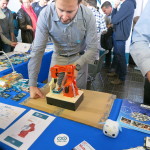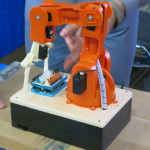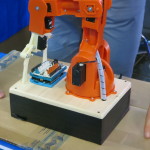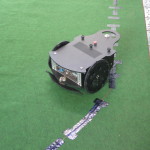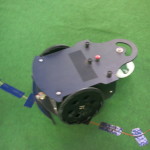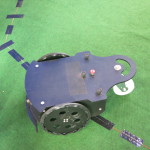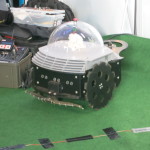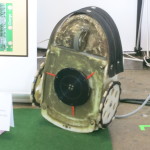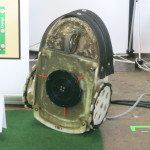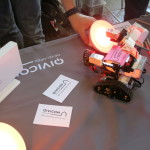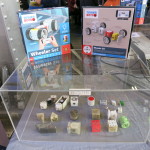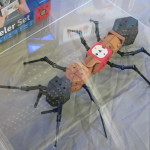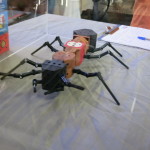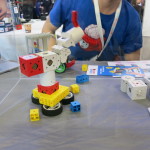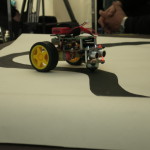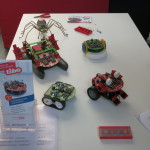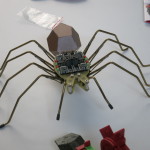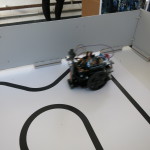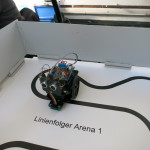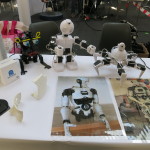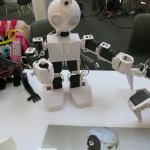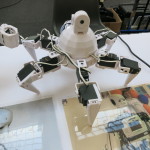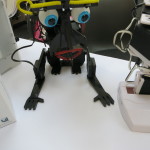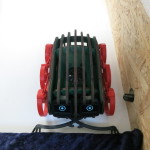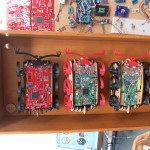http://motherboard.vice.com/read/how-to-build-a-robot-that-will-feed-you-breakfast
Schweizer Premiere mit autonomen Shuttles
Mitteilung vom 04.11.2015
Im Auftrag der Post will die PostAuto Schweiz AG in Sitten zusammen mit weiteren Partnern wie der Stadt Sitten, dem Kanton Wallis sowie der ETH Lausanne während zwei Jahren zwei autonome Fahrzeuge testen.
Im Auftrag der Post will die PostAuto Schweiz AG in Sitten zusammen mit weiteren Partnern wie der Stadt Sitten, dem Kanton Wallis sowie der ETH Lausanne während zwei Jahren zwei autonome Fahrzeuge testen. Es ist das erste Mal, dass ein Transportunternehmen in der Schweiz diese Technologie im öffentlichen Raum einsetzt, um Passagiere zu befördern. PostAuto möchte als Anbieter ganzheitlicher Mobilitätslösungen herausfinden, ob und wie diese intelligenten Fahrzeuge neue Formen der Mobilität in Gebieten ermöglichen, die derzeit vom öffentlichen Verkehr nicht bedient werden.
PostAuto und die Stadt Sitten wollen im Rahmen des Mobilitätslabors (Mobility Lab Sion-Valais) Tests mit zwei autonomen Shuttles durchführen. Die zwei vom französischen Unternehmen Navya entwickelten Fahrzeuge werden zu 100% elektrisch angetrieben. Falls der Testbetrieb von den zuständigen Behörden bewilligt wird, befördern die beiden Shuttles bis zu neun Personen bei maximal 20 Kilometern pro Stunde durch die Strassen des Walliser Hauptorts. Dabei sind sie zwar immer von instruierten Personen begleitet, verkehren aber vollautomatisiert und verfügen weder über ein Lenkrad noch über Brems- und Gaspedale. Im Bedarfsfall steht jedoch ein Notfallknopf zur Verfügung, um das Fahrzeug anzuhalten. Dank modernster Sensoren können die Fahrzeuge tagsüber wie auch nachts auf den Zentimeter genau fahren und sämtliche Hindernisse und Signalisierungen auf der Strasse erkennen. Ein Programm des Schweizer Start-up-Unternehmens BestMile überwacht und steuert die beiden autonomen Fahrzeuge.
Erste Testphase ohne Passagiere
Die Einführung dieser Shuttle-Fahrzeuge, die 4,80 Meter lang und 2,05 Meter breit sind, findet in zwei Phasen statt. In der ersten Phase von Dezember 2015 bis ungefähr Frühling 2016 werden die Fahrzeuge von Fachspezialisten auf einem abgesperrten Privatareal getestet. Falls die zuständigen Behörden den Pilotversuch bewilligen, werden die autonomen Shuttles in der zweiten Phase im öffentlichen Raum verkehren und Personen befördern. Dafür ist ein Gebiet vorgesehen, das die Fussgängerzone sowie die Begegnungszone der Altstadt von Sitten und das touristische Zentrum der Stadt umfasst sowie zu den Schlössern Tourbillon und Valère führt (siehe Plan). Wenn die Tests in diesem Gebiet erfolgreich sind, ist der Einsatz der Fahrzeuge auch auf anderen Strecken in der Stadt Sitten vorstellbar.
Sonderbewilligungen nötig
Die gesetzlichen Bestimmungen für den Einsatz autonomer Fahrzeuge auf öffentlichen Strassen sind derzeit noch nicht abschliessend geregelt. Deshalb braucht es für die Durchführung des Pilotversuchs in der Stadt Sitten Sonderbewilligungen der Behörden. PostAuto arbeitet diesbezüglich eng mit dem Fahrzeughersteller und den zuständigen Behörden auf Bundes-, Kantons- und Gemeindeebene zusammen. Alle am Test beteiligten Firmen und Institutionen legen grössten Wert auf die Sicherheit der Fahrgäste, weshalb noch nicht genau abschätzbar ist, ob und wann die Bewilligungen erteilt werden können.
Immer leistungsfähigere Flottenmanagementprogramme
Parallel zu diesem einzigartigen Pilotversuch in Sitten arbeitet die ETH Lausanne daran, eine Flotte autonomer Shuttles in das System des öffentlichen Verkehrs zu integrieren und beispielsweise einen bedarfsorientierten Dienst zu ermöglichen. Eine zentrale Voraussetzung ist, den Betrieb in Echtzeit durchzuführen und den unterschiedlichen Bedürfnissen der Passagiere Rechnung zu tragen: flexible Fahrpläne, Ruflinien, Haus-zu-Haus-Dienste usw. Sind die dazu notwendigen Algorithmen einmal entwickelt, können sie zur Verbesserung des Flottenmanagementprogramms von BestMile beigezogen werden. Darüber hinaus werden sie allgemein zu Lösungen in der Logistik und im Management des öffentlichen Verkehrs beitragen. Durch den Pilotversuch im öffentlichen Raum in Sitten können die Algorithmen der ETH Lausanne weiter entwickelt werden.
Den Nutzen von autonomen Shuttles im öffentlichen Raum testen
PostAuto und die Stadt Sitten möchten zusammen mit ihren Partnern herausfinden, ob der Einsatz von autonomen Shuttles im öffentlichen Raum einen Kundenmehrwert bietet. Insbesondere stellt sich die Frage, ob deren Einsatz im öffentlichen Raum – beispielsweise in Fussgängerzonen und autofreien Ortschaften – oder auf Firmengeländen möglich ist. Weiter wollen das Transportunternehmen und der Walliser Hauptort Erfahrungen mit neuen Formen der Personenmobilität machen und die Möglichkeit schaffen, Orte zu erschliessen, die bisher vom öffentlichen Verkehr nicht bedient wurden. Es ist jedoch nicht das Ziel, auf den bestehenden Linien Busse durch autonome Fahrzeuge zu ersetzen, sondern die Transportmittel zu diversifizieren, um möglichst viele Mobilitätsbedürfnisse der Fahrgäste abzudecken.
Die Mobilität der Zukunft gestalten
PostAuto ist daran, sich vom führenden Busunternehmen im öffentlichen Verkehr der Schweiz zu einem Mobilitäts- und Technologiedienstleister weiter zu entwickeln. In diesem Zusammenhang will PostAuto im Auftrag der Schweizerischen Post moderne Technologien verantwortungsvoll prüfen und einsetzen, um neue Mobilitätslösungen im öffentlichen Verkehr und an der Schnittstelle zum Individualverkehr zu finden. Um dies zu ermöglichen sucht PostAuto gezielt Partner, die sich strategisch und finanziell engagieren. Beim Projekt «autonome Shuttles» in Sion steht PostAuto mit diversen Unternehmen im Kontakt. Mit ihnen zusammen will die Schweizerische Post die Mobilität der Zukunft maßgebend mitgestalten.
Kraftwerk – Roboter – Lemmchen Grundschule
Kinder der 1. Klasse (GTS Lemmchen Mainz-Mombach) basteln, singen und spielen Roboter von Kraftwerk.
PHIRO: A LEGO® compatible robot for all kids. Learn to Code in 5 ways.
Cambridge, MA, November 2nd, 2015- Robotics Education Startup Robotix USA, LLC, lead by two sisters, Deepti Suchindran and Aditi Prasad, with a mission to inspire the innovators of tomorrow, announced today it is raising funds via a crowdfunding campaign on Kickstarter to develop coding toys for kids, that makes learning to code fun and easy. The company set out to raise funds on Kickstarter to produce the first batch of their innovative robots, Phiro, that is going to change the educational robotics market. (Phiro on Kickstarter is selected as a Kickstarter ‘Staff Pick’. Link to Kickstarter http://kck.st/1SjqW7H)
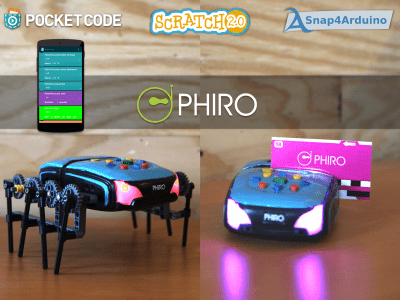
Robotix has many years of experience teaching coding and robotics to several K-12 schools. They have evaluated educational robots from all over the world and found gaps. The robots are usually expensive, use proprietary programming languages and are not so fun for kids. Robotix has created Phiro, an affordable robotics & coding toy that helps kids learn to code and develop computational thinking skills. Kids can learn to code in 5 ways, either without a computer or with open-source programming languages that millions of kids use and love. Phiro is a LEGO® compatible robotics toy that kids can play, code & innovate with to develop 21st century skills.
“In today’s technology-driven and rapidly changing world, being computational thinkers to solve problems is an essential skill for children to learn. Computational thinking is a critical 21st century skill that is relevant to all fields from economics, sports, medicine, law, and engineering. Research shows that one of the most effective ways for kids, as young as 4, to learn computational thinking is through coding and robotics”- said Deepti Suchindran, PhD, CEO, Robotix USA.
“With Phiro children get to see the practical application of programmes they have created instantaneously”- said Dr. Wolfgang Slany, Professor of Computer Science & Head of the Institute for Software Technology, Graz University of Technology, Austria.
With Phiro, kids can play music, make a movie, create games, flash lights, detect faces and much more. Coding and playing with Phiro empowers and inspires kids to be creators and innovators of tomorrow. Robotix has created two robots: Phiro Unplugged & Phiro Pro. Both robots come fully assembled and are ready to learn from & play with, right out of the box.
Phiro Unplugged for kids ages 4 to 8. Kids can learn to code & program the robot without a computer! Phiro Unplugged is a great robotic tool to learn Sequential programming and Binary Coding.
Phiro Pro for young people ages 9 to 18. Kids can program Phiro Pro with a computer, tablet or smartphone connected wirelessly via Bluetooth to Scratch 2.0 (MIT, USA), Snap4Arduino (UC Berkeley/Citilab, Spain), Pocket Code mobile apps (Graz University of Technology, Austria). Learners can connect to a community on-line enabling collaboration, sharing & learning. Phiro Pro also has all the capabilities of Phiro Unplugged.
“In one package Phiro does what a whole lot of other systems do individually so it really helps to bring all those together … and make it more cost effective for the classroom”- said Daniel Riles, Technology Integration Specialist, Brookwood School, Boston, USA.
Robotix has launched a Kickstarter campaign to raise funds to manufacture the robots for the global market, which will be ready for Kickstarter supporters in the 2nd quarter of 2016 with special Kickstarter launch prices at $99 (Phiro Unplugged) and $149 (Phiro Pro) during the campaign. Crowdfunding and detailed features of Phiro Unplugged and Phiro Pro can be found here: www.robotixedu.com and on our Twitter at twitter.com/RobotixLS and Facebook at facebook.com/robotixedu
Personal Intelligent Robots with Android Phone and LEGO
ELFi Robotics startup by Google Science Fair finalist Mark Drobnych is now on Kickstarter
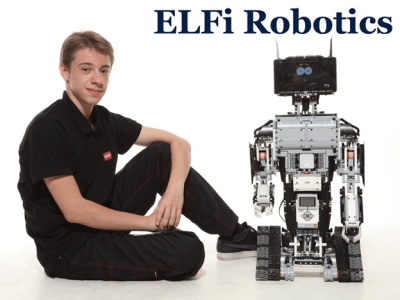
28 of October 2015 – New startup ELFi Robotics based in Ukraine announced today that it is raising funds via rewards crowdfunding campaign on Kickstarter to finish the development of their revolutionary Android apps for robotic applications. The company set out to raise £33,000 on KickStarter to finish development of innovative software platform for DIY smart robots built with wide-accessible construction sets of Lego, Tetrix, Arduino and Raspberry Pi .
ELFi Robotics offers a Minimal Viable Product – Robotic Platform for learning and building intelligent robots. This platform comprises of: Brain App for Android (iOS soon), Robots, Platform Tools, RoboMarket, Training program.
ELFi Brain App is a robotic brain which can be installed on Android device and connected to LEGO EV3, Arduino or Raspberry Pi controllers. So any LEGO Robot can receive its missed brain from now on!
ELFi Educational Program covers both hardware and software aspects required to understand basics of robotics. Both aspects start from very simple patterns and don’t assume any previous experience in robotics. ELFi Robotics WorkBook and Building Instructions Book by Mark allow a quick start for any beginner.
The powerful concept of RoboMarket and “Robotics for programmers” book allows third-party developers to write applications for ELFi Robots and even sell them.
According to Mark Drobnych, 15 years old CEO of ELFi robotics: “Our main target is to provide robots to everybody. Nowadays, real robots are really expensive and rare. I think it’s time to enter the new era of technologies. Build your own robot, with own design, and own set of functions! Our Brain app and platform are flexible enough to support new robotics ventures.”
The story begun two years ago when 13-years old Mark Drobnych worked on his personal scientific research: School Presentation of Microscope. The results of this work were presented at the Final of Google Science Fair 2014 in Mountain View, California. As functions of microscope started being more complex Mark had an idea to create an universal Robotic Brain on top of Android operating system. This Brain had to create human-friendly spoken interface not only for his Presentation of Microscope but for ANY ROBOTIC BODY built with Lego, Arduino, Tetrix or Raspberry Pi parts. It was ELFi birth.
To enforce his progress on software part Mark involved his dad, Oleksiy Drobnych, PhD, into the project as an experienced software engineer.
In the UK Mark is represented by Androcommerce Ltd., registered in England family firm focusing on mobile e-commerce offering.
- Campaign Page URL: www.kickstarter.com/projects/39346890/elfi-robotics-your-own-robotics-lab
Pictures Maker Faire Berlin 2015
Dash Robotics Unveils Kamigami, its First Line of Animal-Inspired Robots
HAYWARD, Calif. (October 20, 2015) — Dash Robotics today unveiled the first generation of bio-inspired Kamigami robots, the first advanced robot toy available for less than $70. Kamigami are fast, lightweight, build-it-yourself robotic toys that snap together in an origami-like fashion. Kamigami fit in the palm of your hand, run very fast on six legs, and are controlled by a programmable mobile app (for iOS initially, Android coming in 2016). Kamigami will be available initially through Kickstarter, for $49 – a 30% discount off the MSRP of $69. Kamigami will be available directly from Dash Robotics and at Amazon.com in 2016.
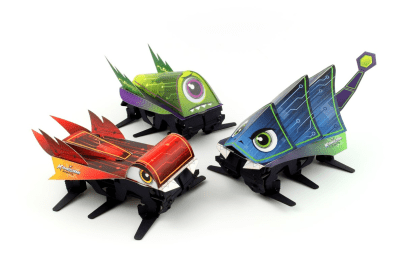
Dash created Kamigami robots to bring programmable robotics to the mass market. Its low price point makes it the most accessible robotic toy ever. The DIY nature of Kamigami along with the simplicity of drag-and drop programming for changing and evolving each individual robot is intended to inspire kids everywhere to engage with, and learn from, advanced technology in a way that is easy, affordable, social and fun.
Kids can use easy drag-and-drop programming within the mobile app to modify the behavior of each individual robot, and can toggle between individual and team play modes. A simple yet sophisticated set of electronics included with each robot are easy for anyone to install. These include a small circuit board, battery, a light sensor, IR sensor, gyroscope and accelerometer, which combine to bring Kamigami to life. With the IR sensors, Kamigami robots can tag one another remotely in team play modes, such as tag or battle games. IR signals transmitted from one robot to another can cause different player-designed effects on the tagged robot.
Kamigami are evolved from the initial Dash Robot beta, released last year to test design and get early customer feedback. The core “skeleton” or chassis of Kamigami looks much like the original Dash beta, whose rapid movements mimic the movements of animals, particularly cockroaches and lizards. The founders of Dash studied biomimicry and robotics at the University of California, Berkeley. In a new twist, Kamigami feature interchangeable shells that snap over the chassis, turning the robot into a colorful creature from out of this world.
Nick Kohut, co-founder and chief executive officer of Dash Robotics, said, “We designed Kamigami so kids could discover a fun new way of learning. Our mantra is ‘build, program and evolve’ and Kamigami helps kids do just that. It’s the first DIY programmable robot that is affordable for everyone.”
Key Features of Kamigami Robots:
■ Do-It-Yourself: Kamigami can be assembled without tools in under an hour. No glue or soldering required.
■ High-speed: High speed and robust locomotion inspired by some of nature’s fastest runners.
■ iOS compatible: Free app allows you to control and program the robot. Android app coming soon.
■ Rechargeable: Built-in high performance rechargeable battery. Recharges in about 30 minutes. 45-60 minutes of playtime per charge.
■ Advanced sensor suite: Includes 10 different sensors, for things such as rotation, acceleration, sensing and responding to ambient light, sending and receiving infrared signals.
■ Robot-to-robot communication: Infrared communication allows robots to talk to each other, allowing the robots to cooperate or compete.
■ Durable: Robot’s flexible construction allows the robot to shrug off falls and collisions.
Programmable Behavior
Each Kamigami robot can be programmed with a unique set of behaviors and characteristics.
This enables a wide range of individual and team play modes that take advantage of the robot’s sensors and functions. Games that can be created include:
■ Sumo-bots – first to fall off the table loses points
■ Build your own battle game where robots blast each other with the IR lasers
■ Robot relay – one robot cannot run until it gets tagged by another robot
■ Tanks – take turns trying to get into firing position
Mechanical Intelligence
Most robots today are constructed either with hundreds of expensive injection-molded parts, or metal fastened together with steel bearings. They require an individual motor, or actuator, for each joint, making them slow, expensive and heavy. To overcome these fundamental challenges, Dash constructs its robots with a material made up of highly durable yet lightweight plastic.
This material fastens together using flexible plastic joints, or flexures, rather than ball bearings. Because of this design approach, Kamigami robots require only one or two actuators – another significant reduction in cost for both prototyping and manufacturing.
This rare combination of new composite material, intelligent design and innovative manufacturing results in robots that have much greater mechanical flexibility, are much faster, are lighter in weight and can be sold at a fraction of the cost of any competitor.
About Dash Robotics
Dash Robotics was founded in 2013 by four UC Berkeley PhD students on a mission to make advanced robotics simple, fun and affordable for everyone. Dash has received a round of seed funding led by IronFire Capital, which has a track record of success investing in early-stage companies including Songza (acquired by Google), Streem (acquired by Box), Caviar (acquired by Square) and many others. Dash is headquartered in Hayward, California.
Meet OhBot, a “human” robot for children
A London inventor has created an educational robot that kids can use to boss around their parents.
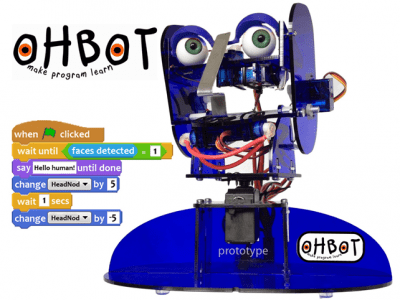
Mat Walker, and his business partner Dan Warner, have together developed OhBot, a talking robot head that can be programmed to follow simple instructions. The educational robot was created in the top room of Walker’s house in Hornsey, north London. And now the invention is set to be sold worldwide.
Primary school kids as young as seven can teach Ohbot to tell their parents to “Go and tidy your room”, “To eat up your broccoli” or to “switch the telly off at once!”
Mat Walker, a roboticist, said: “Ohbot is a brilliant way to teach kids the skill of coding – what parents used to call ‘computer programming’. Most children find programming Ohbot really easy to pick up. They’re much better at this sort of thing than their parents.
“Ohbot can do so many things. It can talk, move its head, smile and frown. You can program its eyes to follow you around the room.
“Ohbot is great for children of all ages from about six. It appeals as much to girls as to boys.
“But what kids like the most is the way it talks. You tell it what to say and its lips synchronise automatically with the words you’ve given it. I’ve seen so many children make Ohbot tell their parents to behave!”
Co-creator Dan Warner added: “Kids love accessorising Ohbot. You can make some hair out of pipecleaners, stick a hat on it, give it a pair of cool sunglasses.”
Ohbot is different from previous educational robots because it’s in “human” form, rather than “turtle shaped” like the vast majority of robots that have been in schools since the 1960s.
Walker says: “Turtles are fine. But why shouldn’t children create and invent using a robot that looks just like them?”
Unlike most of those old-fashioned robots, Ohbot can talk, display emotions, act, react and solve real world problems.
It can be programmed to teach spellings or maths, ask questions and record the answers, even lead a cookery demonstration! You simply plug Ohbot into a PC computer and it’s ready to be programmed. Until now, Walker and Warner, from Stroud in Gloucestershire, have been taking their invention around schools.
But this month (17 Oct) they have released it on sale directly to families.
Anyone wanting to buy one simply logs on to the kickstarter website www.tinyurl.com/ohbot2 and pledges either £149 for a ready-made Ohbot or £99 for one in kit form – and as soon as 100 pledges have been made, the production line will start producing the robots, ready to be delivered in time for Christmas.
Walker says: “Ohbot has been a tiny cottage industry so far but it’s ready to move into the mainstream.
“We’ve taken Ohbot into lots of schools and they love it. But now we’re ready to offer Ohbot directly to parents and grandparents at home.”
CellRobot Launching Modular Robots for Futuristic Applications

Src:Card The Card Game – The Robot Hacking, Computer Programming Card Game has launched on Kickstarter.
Sept, 2015 – Src:Card Games has completed their first standalone card game: Src:Card. Src:Card is a two player (3-4 player with expansion) card game that pits players against each other as nation states. Each nation has one super robot with the ability to conduct global warfare. With the days of human combatants in the past, players must write code in order to defeat the all-powerful combat robots.
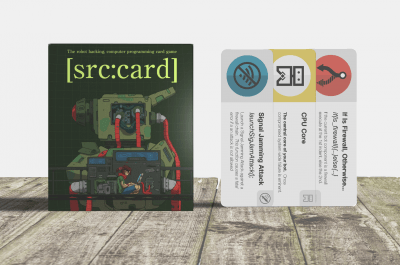
Each player alternately develops its robot’s defences and programs an attack against its opponent’s battle robot. The game uses fundamental concepts from programming in order to facilitate the attack mechanisms within the game. The dynamic nature of building robotic defences leads to a remarkably agile response from players.
Src:Card is a game of anticipation, defence and programmatic offence. The code based mechanics of the game are challenging for beginners and become more challenging as players become more adept at using the programming blocks. Src:Card was created by Sam Boychuk, Erwin Njembo and Jacob Grossman, each big fans of tabletop gaming and computer programming.
After exploring research topics in software engineering education, Sam Boychuk – lead developer – determined that academics where stressing the need to teach programming students a handful of basic concepts. Two years ago Sam decided to create a Java-based visual programming language called Pipes, as a continuation of these studies. Six months ago, the team decided that the ideas in Pipes could be better represented in a tactile standalone card game. While incorporating cutting edge research in teaching programming, Src:Card incorporates foundational computer science lessons in an effort to entertain and educate players of the game.
While it is the primary goal of the Src:Card team to entertain, they are confident that exploring foundational topics in computer science can introduce a whole new generation of technology enthusiasts to the world of software development. Erwin Njembo, a teacher and technology student stated “Src:Card is engaging, it is fun, it is competitive, it’s actually a game that keeps you on the edge, you have to use your brain all the time.” Src:Card is looking forward to releasing the game on Kickstarter immediately.

